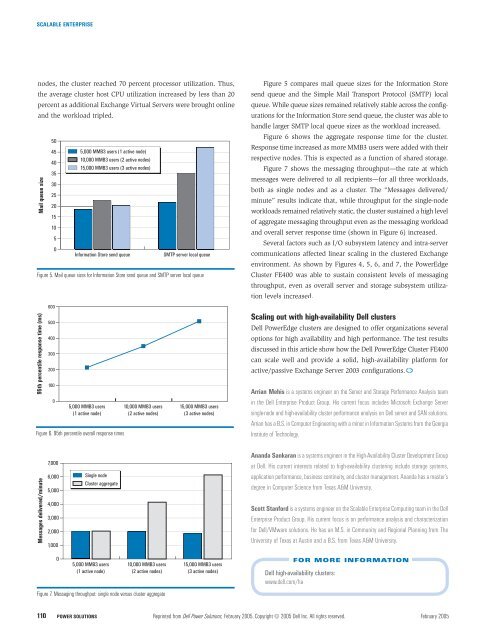Dell Power Solutions
Dell Power Solutions
Dell Power Solutions
- No tags were found...
You also want an ePaper? Increase the reach of your titles
YUMPU automatically turns print PDFs into web optimized ePapers that Google loves.
SCALABLE ENTERPRISEnodes, the cluster reached 70 percent processor utilization. Thus,the average cluster host CPU utilization increased by less than 20percent as additional Exchange Virtual Servers were brought onlineand the workload tripled.Mail queue size504540353025201510505,000 MMB3 users (1 active node)10,000 MMB3 users (2 active nodes)15,000 MMB3 users (3 active nodes)Information Store send queueSMTP server local queueFigure 5. Mail queue sizes for Information Store send queue and SMTP server local queueFigure 5 compares mail queue sizes for the Information Storesend queue and the Simple Mail Transport Protocol (SMTP) localqueue. While queue sizes remained relatively stable across the configurationsfor the Information Store send queue, the cluster was able tohandle larger SMTP local queue sizes as the workload increased.Figure 6 shows the aggregate response time for the cluster.Response time increased as more MMB3 users were added with theirrespective nodes. This is expected as a function of shared storage.Figure 7 shows the messaging throughput—the rate at whichmessages were delivered to all recipients—for all three workloads,both as single nodes and as a cluster. The “Messages delivered/minute” results indicate that, while throughput for the single-nodeworkloads remained relatively static, the cluster sustained a high levelof aggregate messaging throughput even as the messaging workloadand overall server response time (shown in Figure 6) increased.Several factors such as I/O subsystem latency and intra-servercommunications affected linear scaling in the clustered Exchangeenvironment. As shown by Figures 4, 5, 6, and 7, the <strong>Power</strong>EdgeCluster FE400 was able to sustain consistent levels of messagingthroughput, even as overall server and storage subsystem utilizationlevels increased.95th percentile response time (ms)60050040030020010005,000 MMB3 users(1 active node)Figure 6. 95th percentile overall response times10,000 MMB3 users(2 active nodes)15,000 MMB3 users(3 active nodes)Scaling out with high-availability <strong>Dell</strong> clusters<strong>Dell</strong> <strong>Power</strong>Edge clusters are designed to offer organizations severaloptions for high availability and high performance. The test resultsdiscussed in this article show how the <strong>Dell</strong> <strong>Power</strong>Edge Cluster FE400can scale well and provide a solid, high-availability platform foractive/passive Exchange Server 2003 configurations.Arrian Mehis is a systems engineer on the Server and Storage Performance Analysis teamin the <strong>Dell</strong> Enterprise Product Group. His current focus includes Microsoft Exchange Serversingle-node and high-availability cluster performance analysis on <strong>Dell</strong> server and SAN solutions.Arrian has a B.S. in Computer Engineering with a minor in Information Systems from the GeorgiaInstitute of Technology.Messages delivered/minute7,0006,0005,0004,0003,0002,0001,000Single nodeCluster aggregateAnanda Sankaran is a systems engineer in the High-Availability Cluster Development Groupat <strong>Dell</strong>. His current interests related to high-availability clustering include storage systems,application performance, business continuity, and cluster management. Ananda has a master’sdegree in Computer Science from Texas A&M University.Scott Stanford is a systems engineer on the Scalable Enterprise Computing team in the <strong>Dell</strong>Enterprise Product Group. His current focus is on performance analysis and characterizationfor <strong>Dell</strong>/VMware solutions. He has an M.S. in Community and Regional Planning from TheUniversity of Texas at Austin and a B.S. from Texas A&M University.05,000 MMB3 users(1 active node)10,000 MMB3 users(2 active nodes)Figure 7. Messaging throughput: single node versus cluster aggregate15,000 MMB3 users(3 active nodes)FOR MORE INFORMATION<strong>Dell</strong> high-availability clusters:www.dell.com/ha110POWER SOLUTIONS Reprinted from <strong>Dell</strong> <strong>Power</strong> <strong>Solutions</strong>, February 2005. Copyright © 2005 <strong>Dell</strong> Inc. All rights reserved. February 2005








